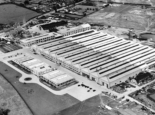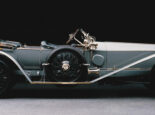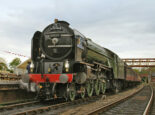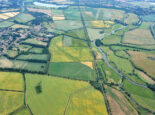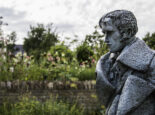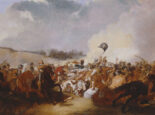Perkins Engines – Built in Peterborough
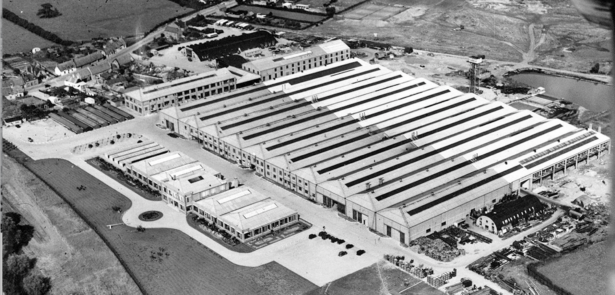
Perkins is one of Peterborough’s greatest success stories; founded in the 1930s, it still calls the city its home, despite its operations spreading across the globe. Originally published in November 2011 as part of a collection of heritage articles, we revisit this truly fascinating story...
Above the original main entrance of the sprawling Perkins Engine Company Limited plant in Eastfield is carved a motto: ‘Where there is no vision, the people perish’. The saying, from the Bible, has become so closely associated with Frank Perkins, the founder and much-respected patrician of what was once regarded as an extended family just as much as a firm, that many think he coined it. His adopted motto is a creed that both the man and his company paid great heed to.
For, having passed its three-quarter century, one of Peterborough’s best-known industrial concerns has done anything but perish. It has successfully survived the constantly changing world since its 1932 birth through a combination of innovation, determination, reputation and quality engineering to become a global leader in diesel engine technology. It’s also a company that, although it has expanded, diversified and changed ownership, still resolutely regards Peterborough as home. However, despite having employed thousands of local people over the decades and being well-known within the area – for many, Peterborough and Perkins are inextricably linked – quite what Perkins now does, and has done in the past, is less recognised. There’s a lot more to it than just bolting together diesel engines and having the bit of Peterborough’s Parkway system that passes its main entrance christened after the man who started it all.
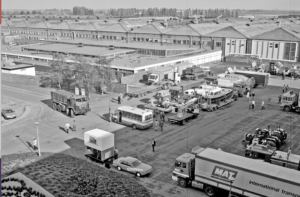 The story of Perkins begins primarily with two men: one famous – to Peterboroughians at least – the other less so, but still just as vital to the company’s early success. Francis Arthur Perkins was born in 1889 in Peterborough, while Charles Wallace Chapman’s birth was in Lancaster in1897. Francis – or Frank as he was better known– was part of a family of agricultural engineers, and educated at Rugby School and Emmanuel College, Cambridge, from where he emerged with an engineering degree. Charles got his equivalent from Liverpool University, interrupted by the First World War when he served as a lieutenant in the navy. During the same conflict, Frank joined the army and rose to the rank of major.
The story of Perkins begins primarily with two men: one famous – to Peterboroughians at least – the other less so, but still just as vital to the company’s early success. Francis Arthur Perkins was born in 1889 in Peterborough, while Charles Wallace Chapman’s birth was in Lancaster in1897. Francis – or Frank as he was better known– was part of a family of agricultural engineers, and educated at Rugby School and Emmanuel College, Cambridge, from where he emerged with an engineering degree. Charles got his equivalent from Liverpool University, interrupted by the First World War when he served as a lieutenant in the navy. During the same conflict, Frank joined the army and rose to the rank of major.
Frank ran a farm in Hertfordshire briefly, before coming back to the family firm of Barford and Perkins in Peterborough. Eventually, that became part of the Agricultural and General Engineers (AGE) Group, leading Frank to become a director of its Aveling and Porter arm in Rochester, Kent. It was there he met Charles, who had come to AGE via Beardsmores and Vickers-Petters, where he’d learnt a great deal about diesel engines, back then still a fledgling technology.
The sprawling AGE conglomerate went bankrupt in 1932. Frank and Charles, now friends, discussed the future together and, fortunately dismissing an initial idea of buying a laundry in Sevenoaks, decided to explore the untapped possibilities of diesel engines for use in cars and small trucks. Up until this date, diesel engines had been large, low- revving monsters, mainly used for marine, railway and agricultural applications. The plan for what would eventually become Perkins was formed in March 1932 at Charles’ house in Strood, Kent. And it almost ended the same day – driving back to the railway station after the talks, Charles and Frank were involved in a heavy collision with a lorry that wrote off the car they were in.
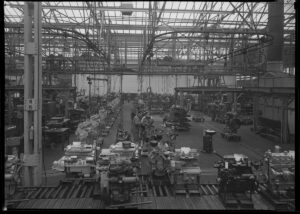 The early days of Perkins
The early days of Perkins
With the old Barford and Perkins premises back at Queen Street in Peterborough (an area now vanished under the Queensgate Shopping Centre and bus station) vacant, the decision was taken to start the new company back in Frank’s home city, where there was a rich pool of engineering labour and talent available and the Perkins name was already well-known and respected. Like one of the other great manufacturing partnerships originating from Peterborough, Rolls-Royce (Henry Royce having been born at Alwalton), the embryonic F Perkins Ltd, Engineers was run with Frank as the business brain and Charles the technical guru. The first engine, dubbed Vixen, was complete by December 1932. Perkins’ first years were faltering ones. The successful Wolf engine of 1934 brought in orders, but a tax on diesel fuel the following year nearly finished the company off. Instead, it managed to diversify into engines for larger trucks as well as farming, industrial and marine applications. It also came up with some novel publicity coups including installing a Wolf engine in a racing car and setting new speed records at the banked Brooklands’ circuit in Surrey. A peak speed of almost 95mph was recorded, impressive performance for any vehicle of the era, let alone something powered by a diesel. Alan Richardson, Frank Perkins’ brother-in-law and a director of the company also installed a supercharged Wolf in his personal car; by all accounts, it was capable of phenomenal acceleration from a standstill.
One of Charles Chapman’s greatest creations came along in 1936, with the six-cylinder P6 engine, widely regarded as years ahead of its time. Its designation was a departure from the policy of naming engines after animals but the P6 was originally titled Panther. ‘When they started to market this engine, they ran foul of the company producing Panther motorcycles,’ explains David Boulton, a member of Perkins’ Heritage Group and author of A Square Deal All Round, the comprehensive history book of the firm published in 2007. ‘So they just decided, to heck with it, we’ll call it the P6. So that’s how the engine got its very simple title, and that’s the engine that, really, was the success the company was built on.’
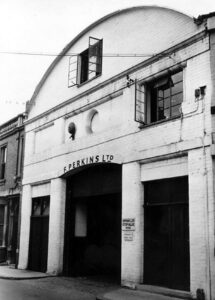 Then came war. From 1939 to 1945, Perkins built 12,000 engines, mainly for maritime use. To put this into perspective, from 1932 until 1936, the company had turned out just 1100. Charles developed a leviathan of an engine, the T12, designed to replace Rolls-Royce Merlin V12 petrol engines in boats so they could be diverted instead to vital aircraft such as Spitfires, Hurricanes and Lancasters. ‘To me, that’s probably the pinnacle of Charles Chapman’s designs, because it’s so different,’ says David of this 1,000 horsepower engine, which never made it past the prototype stage. ‘We’re still not sure about where he got some of his ideas from. But it was a very clever piece of design thinking.’ Charles, however, resigned from Perkins at the end of 1942, following disagreements about how some of his designs were being used. The departure of this original Perkins visionary, as well as its most experienced engineer, left a large gap in the company.
Then came war. From 1939 to 1945, Perkins built 12,000 engines, mainly for maritime use. To put this into perspective, from 1932 until 1936, the company had turned out just 1100. Charles developed a leviathan of an engine, the T12, designed to replace Rolls-Royce Merlin V12 petrol engines in boats so they could be diverted instead to vital aircraft such as Spitfires, Hurricanes and Lancasters. ‘To me, that’s probably the pinnacle of Charles Chapman’s designs, because it’s so different,’ says David of this 1,000 horsepower engine, which never made it past the prototype stage. ‘We’re still not sure about where he got some of his ideas from. But it was a very clever piece of design thinking.’ Charles, however, resigned from Perkins at the end of 1942, following disagreements about how some of his designs were being used. The departure of this original Perkins visionary, as well as its most experienced engineer, left a large gap in the company.
Expansion to Eastfield
During the war, it became clear that the company’s aspirations were being limited by its Queen Street premises, with expansion somewhat confined by the inconveniences of the main London to Scotland railway line on one side and a medieval cathedral on the other. Construction started on a new factory – on Perkins’ current site at Eastfield – just a month after the war ended, and was complete by 1947, after which it started producing 100 engines a day for Perkins’ 101 customers.
Perkins started the 1950s turning out 25,000 engines a year and employing 2,850 people. By the end of the decade, this had ballooned to 75,000 engines and 7,000 workers, helped in no small way by its 4.99 engine, which found its way into popular family cars by Ford, Vauxhall, Morris and Hillman. The company was also floated on the London Stock Exchange, which raised considerable cash for expansion and export drives. But this also allowed Canadian firm Massey Ferguson to acquire enough shares to take over in 1959, when Perkins ran into choppy financial waters with its problematic R6 engine and the Suez Crisis. The Massey Ferguson acquisition saw Frank Perkins step down as managing director after 37years’ service, with the entire shop floor turning out to sing For He’s a Jolly Good Fellow on his final day, a testament to his popularity as a boss and the sense of family and community within the company he instilled. This legacy continues to some extent even today. ‘My colleagues in Brazil used to speak of La Familia Perkins: the Perkins family,’ remembers David. ‘It was a family company, even when there were 10,500 people on this site, back in the 1970s. And there’s still, I think, the remnants of that feeling despite the fact that we are now just a small part of a very big worldwide group.’
Revitalised under Massey Ferguson ownership and with the benefits of a greater global marketplace, Perkins’ rise continued, with 200,000 engines made during 1964 and a Queen’s Award for Export Achievement won two years later. Perkins manufacturing also spread to Argentina, Turkey, Mexico, Bulgaria, Brazil and Japan, via licensing agreements.
‘That strategy, of licensee relationships, has largely vanished in the modern business environment, but at the time, it was a very important part of helping Perkins grow,’ says the company’s marketing director and chairman of the Heritage Group, Nigel Baseley. ‘That was one of the key things in getting us established around the world. We couldn’t have expanded in the way we did without these partnerships.’
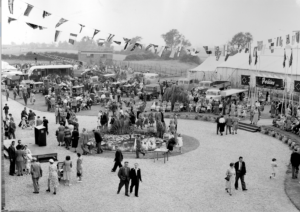 Despite the 1970s being difficult times, Perkins weathered the storm better than many, even managing one year to manufacture almost 270,000 engines, a record achievement. In 1975, a staggering 500,000 Perkins’ engines were built around the world. However, there was some fall-out from the economic strife being suffered throughout the UK, with short-time working being introduced and the firm’s first redundancies exercises. Elsewhere though, Peru, Pakistan, Iran, South Africa and Uruguay were now producing the company’s products under licence, with a brand new engine facility opened in Poland. As if symbolic of how internationally focused and vast Perkins had become, one of the last links with its earliest days was severed with the old Queen Street plant – used for rebuilds and spares – demolished. In its place came the Queensgate Shopping Centre. A blue plaque, unveiled by Queen Beatrix of the Netherlands during its official 1982 opening, is the only reminder that this is where the world’s first high-speed diesel engines were built.
Despite the 1970s being difficult times, Perkins weathered the storm better than many, even managing one year to manufacture almost 270,000 engines, a record achievement. In 1975, a staggering 500,000 Perkins’ engines were built around the world. However, there was some fall-out from the economic strife being suffered throughout the UK, with short-time working being introduced and the firm’s first redundancies exercises. Elsewhere though, Peru, Pakistan, Iran, South Africa and Uruguay were now producing the company’s products under licence, with a brand new engine facility opened in Poland. As if symbolic of how internationally focused and vast Perkins had become, one of the last links with its earliest days was severed with the old Queen Street plant – used for rebuilds and spares – demolished. In its place came the Queensgate Shopping Centre. A blue plaque, unveiled by Queen Beatrix of the Netherlands during its official 1982 opening, is the only reminder that this is where the world’s first high-speed diesel engines were built.
Perkins was less fortunate in the 1980s. The global recession that kicked off the decade initially struck the sprawling parent Massey Ferguson Corporation more than Perkins itself, but the effects filtered down throughout the conglomerate, and Perkins found itself reducing its workforce and plants. Engine production, which had been running at over 200,000 per annum when the decade begun, soon fell to about 130,000. This pessimistic mood cast a cloud over Perkins’ 50th anniversary in 1982, with celebrations muted. However, as economies around the world picked up, so optimism rose again. Perkins even purchased the Rolls-Royce diesel factory in Shrewsbury in 1984, followed in 1986 by another plant belonging to Gardner in Manchester. There was licensee expansion into Turkey and Indonesia, and a deal with Austin Rover to develop a diesel unit for its Maestro, Montego and Sherpa models. The proud boast from Perkins was that this Prima car engine was the ‘first high speed diesel engine capable of 100mph and 100mpg’, and it picked up a Queen’s Award for Technological Achievement.
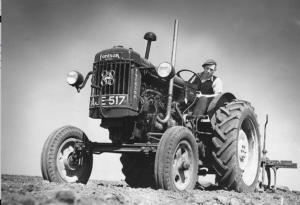 A major innovation during the 1990s was a new philosophy – that of comprehensive training for all employees to release and enhance the full potential of each Perkins person. Or rather Varity Perkins, as the company was briefly called from 1996 when owner Massey Ferguson changed its name to Varity. The identity alteration didn’t last long: Varity merged with the Lucas Group later the same year, and within a couple of years sold the Perkins side of its business to American industrial giant Caterpillar, a customer of the company since the 1970s. One of the welcome sweeps from the new broom was the return to the Perkins name.
A major innovation during the 1990s was a new philosophy – that of comprehensive training for all employees to release and enhance the full potential of each Perkins person. Or rather Varity Perkins, as the company was briefly called from 1996 when owner Massey Ferguson changed its name to Varity. The identity alteration didn’t last long: Varity merged with the Lucas Group later the same year, and within a couple of years sold the Perkins side of its business to American industrial giant Caterpillar, a customer of the company since the 1970s. One of the welcome sweeps from the new broom was the return to the Perkins name.
Heritage in action
Perkins has a strong following among enthusiasts and the Heritage Group often attends events where aficionados can get up close to these items from Perkins’ mechanical past. Engines also go out to museums as well. ‘It helps us both – if we ever achieve our aim of having an example of every engine Perkins ever built, it’s going to be a challenge to store them all,’ laughs Wayne Davey, the external events co-ordinator for the Heritage Group as well as a senior research and development engineer. ‘By loaning our engines to a number of museums, we’re able to promote the Perkins name and show our active support for our heritage’. The group also assists with enquiries from those interested in older engines. ‘We’ll do what we can when we get asked questions, although we are a small team and recommend speaking to your local dealer first. It’s good for us to see a 50- or 60-year-old Perkins engine still in operation!’ It’s not that unusual that they do though – some more hardcore enthusiasts have driven classic Perkins-engined tractors from the UK through the continent, while, for the 75th anniversary of the company, one fan rode his 1950s’ Massey Ferguson all the way from Germany to Peterborough simply for a factory tour.
The final word must go to David Boulton, the man who probably knows more about Perkins’ history than anybody else. ‘There’s an awful lot of interest in heritage, it’s growing, and we need to be part of it. We’re supporting the future by remembering where we’ve been, the paths we used and how we survived. And surviving is a real key part of anything. This company definitely is a survivor.
FOR FURTHER INFORMATION, VISIT WWW.PERKINS.COM








